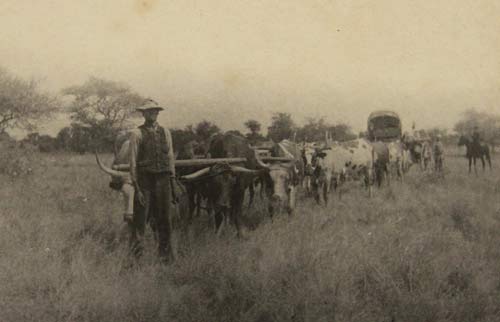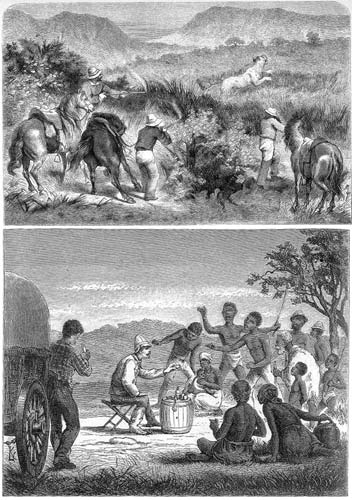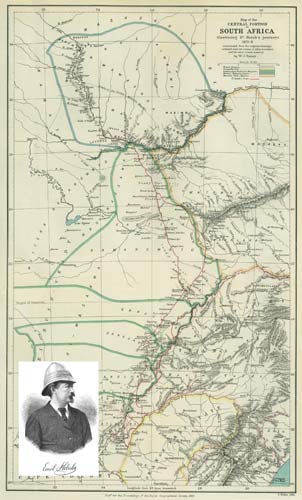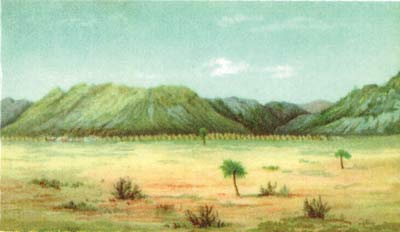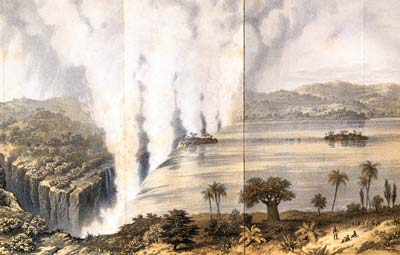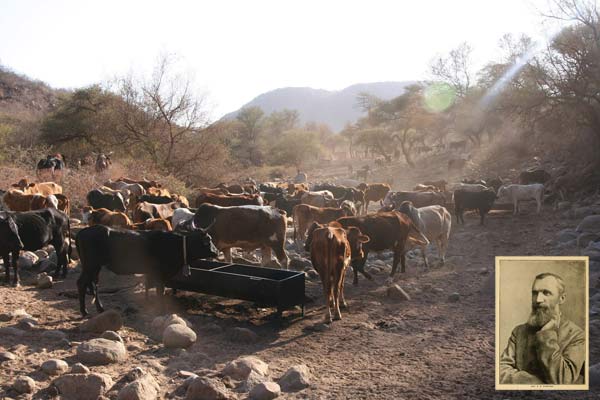Explorers
The 1870�s saw a number of European explorers pass through Shoshong on their way north. One was Frank Oates who passed through Shoshong in 1873, but died of fever (malaria) in 1875 shortly after seeing the Victoria Falls. [1] Although people knew that quinine was effective in fighting malaria, the disease was not properly understood and was a major hazard for Europeans heading north of Shoshong. Explorers and missionaries travelled in ox drawn carts, usually with extra oxen to replace those which died en route.
At that time it was the northernmost station of European civilisation in Central Africa. Our hearts rejoiced as we approached the isolated southern African trading post. Finally we could say to ourselves: the kingdoms of the barbarians now are really behind us, the sphere of white civilisation has been reached and we are closer to our home country. What a difference there is looking at Schoschong from Vienna than looking at it from Maschukulumbe (Ila) country. [2]
Major Serpa Pinto passed through on a coastto- coast expedition in 1877, and various big game hunters including Frederick Selous broke their journeys at Shoshong. [3]
Trade
Trade continued to grow and, as Sekgoma had done before him, Khama made sure that he retained control and that all waggons came through Shoshong. In 1878, 75 tons of ivory from 12,000 elephants was exported via Shoshong and the following year, its total export of ivory was �30,000. Shoshong was the largest, most prosperous and best defended Tswana town, with an army of 3,000 men. [4]There were nine trading stores in Shoshong, usually taking cattle, sheep and goats in exchange for their wares.
Alfred Musson, a Shoshong trader, commented in the 1870s that:
The old trade in ivory, feathers and pelts, in exchange for beads and brass wire, was declining. Instead in accordance with their changing tastes and demands, we stocked roughly-made clothing such as shirts, trousers, guns and ammunition, ploughs and their spare parts (the plough trade soon developed into one of considerable importance) and assorted groceries�. [5]
I know no other Interior Chief who has even attempted the half that Khama has accomplished in the advancing of his people towards the goal of civilisation � His people are living in peace, his fields are laden with corn, the white man�s home is a sacred as in his own country, and a purer morality is growing up from day to day. [6]
By 1880 in addition to the main postal service via Zeerust to Shoshong there was a regular fortnightly mail service by runner from Shoshong via Tati to Bulawayo. It is estimated some seven to eight thousand letters a year passed through Hepburn�s hands. [7]
References
[1] Oates F (1881) �Matabeleland and the Victoria Falls � The Diares & Letters of Frank Oates 1873-1875 edited by C.G. Oates.� C. Keegan Paul & Co, London reprinted[2] Holub E (1975) �From Gazungula (Kazungula) to Schoschong (Shoshong). Our Stay in Schoschong�. Botswana Notes & Records 1975 (Excerpt from book �Travels North of the Zambesi�)
[3] de Serpa Pinto, AA (1879) �Major Serpa Pinto�s Journey across Africa.� Royal Geographical Society & Monthly Record of Geography Vol 1, No 8
[4] Ramsay J, Mgadla PT, Morton B (1996) �Building a Nation.� Longman Botswana
[5] Musson A (apx 1930) �The White Tide, Trading Memoirs of old Shoshong.� Printed 2002 for David Sinclair by Modern Press. Reviewed by N Parsons in Botswana Notes & Records Vol 38
[6] Hepburn J.D (1895) �Twenty Years in Khama�s Country.� Hodder & Stoughton
[7] Rutherford J (2009) �Little Giant of Bechuanaland � A biography of William Charles Willoughby Missionary & Scholar.� Mmegi Publishing House

